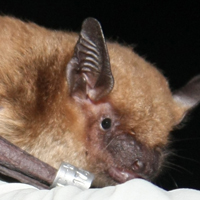Diversity and altitudinal distribution of bats (Mammalia: Chiroptera) on Mount Cameroon

All claims expressed in this article are solely those of the authors and do not necessarily represent those of their affiliated organizations, or those of the publisher, the editors and the reviewers. Any product that may be evaluated in this article or claim that may be made by its manufacturer is not guaranteed or endorsed by the publisher.
Altitudinal distribution and composition of biodiversity are a major current focus in ecology and biogeography, as they provide valuable insights into how biotic communities respond to changing ecological and climatic conditions. In this study, we document bat species richness and abundance along an elevational gradient on Mount Cameroon from sea level to 2,400 m a.s.l. Bats were mist netted in four elevational ranges corresponding to four montane vegetation types: disturbed lowland forest (0–800 m a.s.l.), disturbed sub-montane forest (801–1,600 m a.s.l.), montane forest (1,601–1,800 m a.s.l.), montane scrub (1,801–2,400 m a.s.l.), during the dry and the rainy season from November 2016 to July 2018. Forty-nine days of fieldwork resulted in the capture of 566 bats belonging to six families, 17 genera and 20 species. Species richness peaked at 475 m a.s.l. and decreased at higher elevations. The vast majority of bats captured were frugivorous bats (93.99%). We also observed a difference in species that characterize lower elevations, disturbed habitats (<1,600 m a.s.l.) (including Eidolon helvum, Epomops franqueti, Megaloglossus woermanni, Micropteropus pusillus, Nanonycteris veldkampii) and those that characterize higher elevations with primary vegetation (1,601–2,400 m a.s.l.) (including Lissonycteris angolensis and Rousettus aegyptiacus). Our data indicate that some species are much more likely to be affected by ongoing anthropogenic disturbances than others because of their spatial limitation and restrictions in ecological preferences. Our data also contributes to a better description of the bat fauna of Mount Cameroon including how species are distributed at higher altitude and different montane vegetation types.
PAGEPress has chosen to apply the Creative Commons Attribution NonCommercial 4.0 International License (CC BY-NC 4.0) to all manuscripts to be published.

